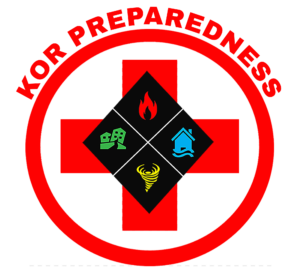
A compass is part of the essential survival gear, and most people take one with them into the mountains without knowing actually how in the world does it work.
Luckily it isn’t too hard to use your compass and when paired with a good map. And, of course, a bit of know-how it becomes a powerful tool for navigation.
Essential Parts of the Compass
It’s going to be hard to talk about how to use the compass without first understanding what all the different parts are for.
So let’s go through that real quick.
- There are rulers that you can use along with your map scale to help you calculate distance.
- A direction of travel arrow reminds you which direction to point the compass when you’re taking a bearing.
- The big arrow called the orienting arrow which we’ll use to help you orient the bezel.
- Some compasses have a handy declination scale which makes it easier to adjust declination.
- The big circle dial with degrees is the rotating bezel which is marked with degrees from N clockwise up to 360.
- There is a little marker called the index line which marks where you’ll read your bearings.
- Inside the bezel, the first thing you’ll notice is the magnetized needle which always points to the magnetic north pole, not the true North Pole.
- Alongside the orienting arrow our orienting lines that you’ll use to help you line up the compass with north on a map.
- A liquid capsule that contains the magnetic needle is rotating housing. The liquid helps dampen the needle movement, making it easier to get a more accurate reading.
- The base plate is clear so you can see the map below it, and there’s always at least one straight edge that you’ll use later for taking bearings.

Setting Declination
Well, declination is the angle difference between true north and magnetic north. The needle in your compass will only point to magnetic north. So right now it’s pointing to somewhere in northern hemisphere not Santa’s workshop. If you don’t adjust your compass to account for the difference between magnetic north and true north, it can really mess up your navigation.
Depending on where you are in the country, the declination will be a certain number of degrees to either the west or the east. You can find the direction, a number of degrees in the declination diagram near the legend along with the date of the maps most recent revision. If your map hasn’t been revised for several years, it’s worth looking up the current declination online.
Different compass brands set declination in different ways and once you know the declination for your region, you can put that information into your compass. When you do and the needle lines up inside the orienting arrow the north marker on the bezel will
point to true north.
“never go outdoors without a compass”
This map above has a declination of 16.01 degrees east, so we need to move the orienting arrow 16.01 degrees to the east. Now that the declination is set you can start using your compass with your map.Taking a Bearing from a Map
First off, a bearing describes a direction in terms of degrees. Bearings are way more precise than just saying go east or west. Instead, you can say to get to the lake, follow a bearing of 79 degrees.
One of the most common ways is to use the bearing is when you’re out hiking and you want to head to a specific point like a peak or your campsite. If you know where you are on a map, it’s a simple process.
Start by finding your current location on the map. Let’s say we’re at point A, now set your compass on the map so that the straight side of the base plate lines up with your position. Next, find the point you want to head toward. Let’s say it’s the point B, and rotate the entire compass until it forms a line between point A and point B. Make sure the direction of travel arrow is pointing in the direction of the peak. Once the compass is in position, rotate the bezel until the orienting lines are lined up with north and south on the map. You can use the edge of the map to help you get the position of the lines just right.
Remember to make sure that the North marker on the bezel is pointing to north on the map and not south. Once the orienting lines are running north-south, look at the index line to read the bearing. Let’s say it is 145.
Congrats, now you can use the compass to follow the bearing. Pull the compass in front of you with the direction of travel arrow pointing away from you. Now rotate your whole body until the north side of the magnetized needle is inside the orienting arrow. If it helps, you can remember “red in the shed”. Once you’ve got red in the shed, you’re facing the bearing of 145 and your destination.

Taking a Bearing in the Field
If you’re out climbing and you want to find your location on a map, you can also take a bearing off a landmark near you.
Then, you can transfer that bearing to your map and figure out where you are.
Start by finding a landmark that you can also identify on your map. Hold your compass up with the direction of travel arrow pointing away from you and directly at the landmark. Now keep the compass flat and rotate the bezel until the magnetized needle is inside the orienting arrow or red is in the shed. Once the needle is in you’ve captured the bearing.
A compass with a sighting mirror makes it easy to take very accurate bearings. Hold the compass at eye level and point it at the object. Then tilt the mirror until you can see straight down into the bezel. This way you can see the object and the bezel at the same time. Once you’ve got the bearing you can transfer it to the map.
Lay your compass on the map and line up its edge with a known landmark. Make sure that the direction of travel arrow is pointing in the direction of the landmark. With the edge of the compass lined up against the object, rotate the entire base plate until the orienting lines are running north-south. And the North marker on the bezel is pointing to North on the map. Once you’ve finished you can draw a line on the map along the edge of your compass. You are somewhere along this line.
Bonus: Triangulation
If you want to find your exact position, you use the process called triangulation. All you have to do is take another bearing but with a different object. That’s at least sixty degrees away from the first. Where the two lines intersect is your position. If you take the third bearing you’ll end up with a little triangle. And the smaller the triangle the more accurate the reading.
Compass skills can be daunting at first but they get way easier with practice. Test them out on your favorite Trail and for more practice.
If you would prefer to go with a more modern GPS unit check out this article!

Special thanks to https://hikecamplive.com/how-to-use-a-compass/
























































